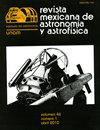日型食双星kic 4832197:组分的物理性质和内在变异性
IF 1.7
4区 物理与天体物理
Q3 ASTRONOMY & ASTROPHYSICS
Revista Mexicana de Astronomia y Astrofisica
Pub Date : 2023-10-01
DOI:10.22201/ia.01851101p.2023.59.02.09
引用次数: 0
摘要
对太阳型食双星系统KIC 4832197的光谱学和空间光度学进行了综合分析。该系统由F7V + F9V组成,质量为M1 = 1.16±0.12 M☉,M2 = 1.07±0.10 M☉,半径为R1 = 1.26±0.04 R☉,R2 = 1.03±0.03 R☉。组件在Log Teff - Log L/L☉平面上的位置表明该系统的年龄为2.8±0.8 Gyr。在时间上观察日食外的亮度显示出一种波状的变化模式,其振幅和形状以天为单位迅速变化。这种可变性的频率分析结果在幅度谱中有两个显著的峰,这被解释为组件上的点的旋转调制。假设两个黑点在同一分量上,微分旋转系数的下限计算为k = 0.12,这比太阳的k☉= 0.189弱。本文章由计算机程序翻译,如有差异,请以英文原文为准。
SOLAR-TYPE ECLIPSING BINARY KIC 4832197: PHYSICAL PROPERTIES AND INTRINSIC VARIABILITY OF THE COMPONENTS
Comprehensive analysis of optical spectroscopy and space photometry of the solar type eclipsing binary system KIC 4832197 is presented. The system is composed of F7V + F9V components with masses of M1 = 1.16 ± 0.12 M☉, M2 = 1.07 ± 0.10 M☉ and radii of R1 = 1.26 ± 0.04 R☉, R2 = 1.03 ± 0.03 R☉. The position of the components on the Log Teff – Log L/L☉ plane suggests an age of 2.8 ± 0.8 Gyr for the system. Inspection of out-of-eclipse brightness in time reveals a wave-like variability pattern, whose amplitude and shape quickly change on order of days. Frequency analysis of this variability results in two significant peaks in the amplitude spectrum, which are interpreted as rotational modulation of spots on the components. Assuming both spots are on the same component, a lower limit for the differential rotation coeffcient is computed as k = 0.12, which is weaker compared to the solar value of k☉ = 0.189.
求助全文
通过发布文献求助,成功后即可免费获取论文全文。
去求助
来源期刊

Revista Mexicana de Astronomia y Astrofisica
地学天文-天文与天体物理
CiteScore
1.30
自引率
10.00%
发文量
14
审稿时长
>12 weeks
期刊介绍:
The Revista Mexicana de Astronomía y Astrofísica, founded in 1974, publishes original research papers in all branches of astronomy, astrophysics and closely related fields. Two numbers per year are issued and are distributed free of charge to all institutions engaged in the fields covered by the RMxAA.
 求助内容:
求助内容: 应助结果提醒方式:
应助结果提醒方式:


